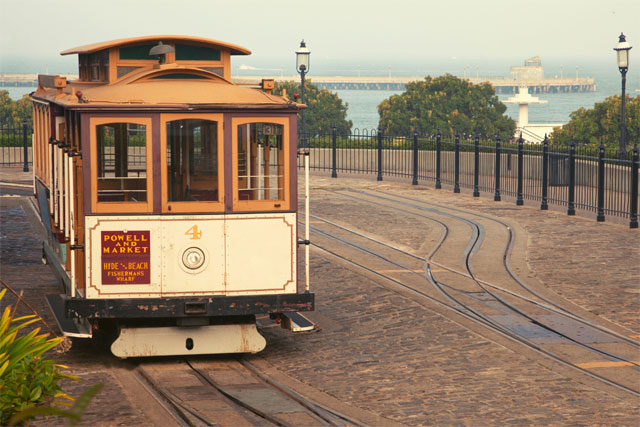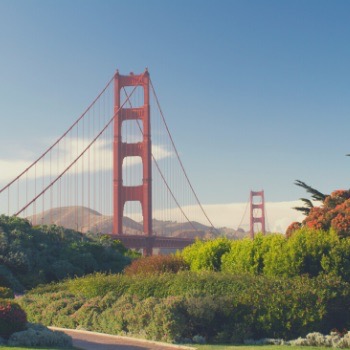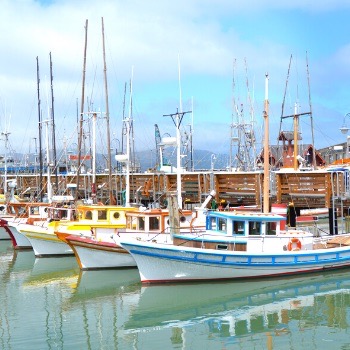SFBU Student’s Guide: How to Get Around the Bay Area

If California is known for one thing, it is the big, sprawling cities that anchor the northern and southern ends of the state. In Southern California, Los Angeles and San Diego together form one, gigantic megalopolis. And yet, Southern California is not well-known for its public transportation system. We’ve all heard of New York’s subway and Chicago’s L-train, but have you heard of the L.A. subway? The situation is a little different in Northern California, where San Francisco’s famous BART heavy-rail public transportation system is quite well-known. Short for Bay Area Rapid Transit, BART connects San Francisco colleges and universities with downtown San Francisco, Chinatown, restaurants, the Golden Gate Bridge, and so much more.
The fact is public transportation systems are part of the backbone of any city. Public transportation provides people with a higher level of mobility, especially in poor or underserved areas. In Fremont and Silicon Valley, not only does public transportation open up routes to San Francisco colleges and universities, no matter how near or far, but it provides access to employment, community resources, healthcare, and recreational activities. Public transportation benefits not only people who choose to ride it but those who have no other choice. According to data from the Federal Highway Administration, over 90% of public assistance recipients do not own a car and instead rely on public transportation to get around.
Comprehensive and widespread public transportation systems are critical for the health of any city, but especially the big ones. Consider that slightly more than 70% of all transit trips are made by passengers who use public transportation five days or more per week. Pre-COVID, San Francisco public transportation had swelled to its highest ridership in recorded history. The BART system recorded, at its height, 426,758 riders in September of 2019. Today, ridership is well below the peak but is recovering. In January 2021, BART recorded 43,012 riders. This past January 2022, it nearly doubled to 83,790 riders. But is the BART the only way to get around? Fortunately, whether you are going to or from San Francisco colleges and universities or heading out to partake in a great outdoor activity, you’ve got options.
A Comprehensive Guide to Getting To and From San Francisco Colleges and Universities
Are you ready for a comprehensive San Francisco public transportation system guide? We’ve got you covered. This primer will ensure you get where you need to go without the excess stress. San Francisco’s public transportation system is managed by the San Francisco Municipal Transportation Agency (SFMTA). The SFMTA governs everything from bicycle lanes to paratransit, parking, buses, traffic, taxis, railways, ferries, and cable cars.
Public transportation in the Bay Area is quite extensive, which can also lead to it being a bit confusing. It includes a rapid transit system, three commuter rail lines, two light rail systems, two ferry systems, Amtrak inter-city rail services, and four major overlapping bus agencies, in addition to dozens of smaller ones.
San Francisco residents, current students, prospective students, and other visitors to our great city have a wide variety of ticket options, transit passes, and modes of transportation to choose from. Let’s dive right in. These are the four primary methods of public transportation in the metro area.
1. Cable Cars and Streetcars: Did you know that the San Francisco cable car system is the last manually operated cable car system in the world? The cable car system in San Francisco is part of the intermodal transportation network operated by the San Francisco Municipal Railway (SFMR). The SFMR itself combines the Muni Metro modern light rail system with the E Market, F Market, and wharves streetcar lines. The first cable car was put into operation in 1873, which also makes San Francisco cable cars one of the oldest cable car lines in the country. And while there were 23 cable car lines at its height, today only three lines remain. What makes cable cars different from other forms of public transportation in San Francisco is their user demographic. Rather than commuters, most of the cable car ridership is composed of tourists. Need routes or schedules? Here you go: SFMTA Cable Cars Information.
2. Buses: San Francisco is a fairly large city with hundreds of buses circulating around its downtown area and beyond, which means a local bus can take you just about anywhere. One of the best ways to get acclimated to the San Francisco bus system is to grab a transport map. Bus stops also have maps on large panels for easy reading. While bus operating times depend on the line, most run between 5:00am and 1:00am. Frequencies also depend on line and time, but one thing you can count on is that all lines that run through the city center will go by every ten minutes or less. Bus fare is generally $2.00 for adults and $0.75 for children 5 to 17 and seniors over 65. For more information on routes and schedules, go here: San Francisco Muni Routes & Stops.
3. Trains: While the San Francisco train system is comprehensive, it can also be quite confusing. The SFMT train system includes BART, Caltrain, Golden Gate Transit, VTA, AC Transit, SamTrans, and Amtrak Inter-City. These systems make up light rail and commuter trains. The Caltrain itself is over 150 years old and is one of the oldest methods of public transportation in San Francisco. When combined with the bus system, city trains can get you just about anywhere, whether you're going to one of San Francisco’s colleges or universities or otherwise. Since there are so many train options, we’ve found a site that connects you to all of them here: San Francisco Trains. Also, here is the official list of BART Schedules and Maps. The BART Trip Planner also provides an interactive map that students can use to plan their trips.
4. Ferries: Being a coastal city, San Francisco also provides access to ferries. While they run on limited schedules, ferries offer calm, quick, traffic-free, and beautiful ways to get around the region. In fact, the San Francisco ferry system is the oldest method of public transportation in the city, with the first ferry being a sailboat ferry going into service in 1826. Today, the San Francisco Bay Ferry and the Golden Gate Transit Ferry are the two primary ferries in San Francisco. Here are your San Francisco Bay Ferry Schedules and Golden Gate Ferry Schedules.
Public Transportation Options in Fremont, California
You need to know all the public transportation options in greater San Francisco if you want to get around the region. But while SFBU is part of the greater San Francisco colleges and universities area, it is still located specifically in Fremont. So, what are the best tips and tricks for students and otherwise who want to make their way around, in, out, and back to Fremont, California?
1. The most widely used and easily accessible station is the BART Fremont Station. From the BART Fremont Station, students can either continue farther out to Warm Springs, Milpitas, or Berryessa or head the other direction into San Francisco proper or the airport.
2. The AC Transit Fremont Station also provides transit options from Fremont into town and back. For AC Transit Station bus schedules check out the AC Transit Trip Planner.
3. Finally, the Altamont Commuter Express (ACE) runs weekdays between Stockton and San Jose and serves ten stations, including Lathrop/Manteca, Tracy, Vasco Road, Livermore, Pleasanton, Fremont, Great America, and Santa Clara.
Why Are Public Transportation Systems So Important?
Public transportation systems are a vital component of the healthy functioning of cities large and small. Consider for a moment that in 2018 alone, over 914,000 California workers commuted to and from work on a public transportation system. Without an updated and viable public transportation system, local municipalities and their economies would crumble. Even more, the environment would be far worse off.
There is little doubt that the benefits of public transportation are amplified when transit networks are planned, engineered, and implemented with interconnectivity, rider experience, and efficiency in mind. Well-thought-out public transportation systems have free amenities like public Wi-Fi, climate control, and cell phone chargers. They may also provide access to food and drink through on-site convenience stores or other retail outlets.
In the end, there is a reason why U.S. News & World Report ranked San Francisco in a tie for first place with New York on their 10 Best Cities for Public Transportation list. With over 650,000 jobs accessible within a 30-minute ride, residents and SFBU students alike can probably get to work faster on public transportation than sitting in traffic.
San Francisco also has a high commuter-to-rider ratio, with 36.5% of daily commuters using public transit. And really, it should be no surprise considering San Francisco has 26 transit routes within a half-mile of each other. Whether you are an SFBU student making your way to and/or from one of San Francisco’s best university campuses or making your way around other cities, favorite beaches, or suburbs in the area, you can rely on San Francisco’s public transit system to get you there!
Are you an SFBU student with specific transportation questions that haven’t been answered in this article? Do not hesitate to contact us today via an online form or give us a call at 510-803-7328. We’ve got you covered!


